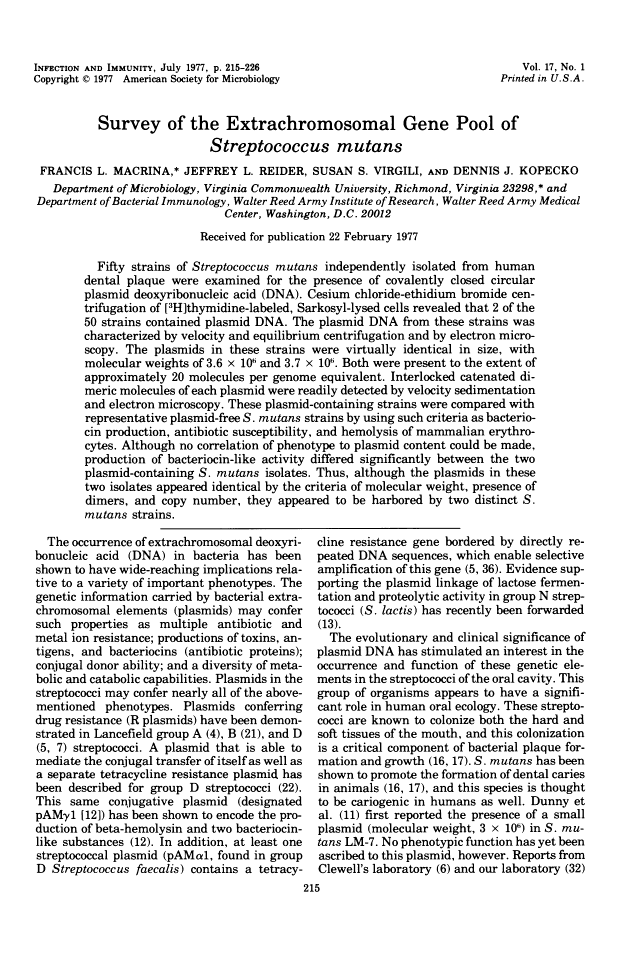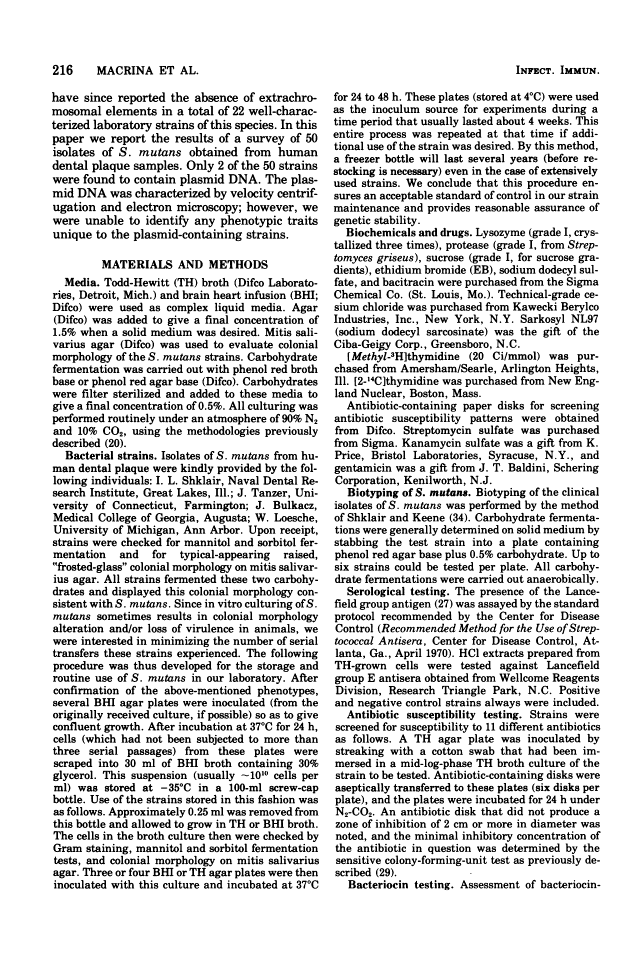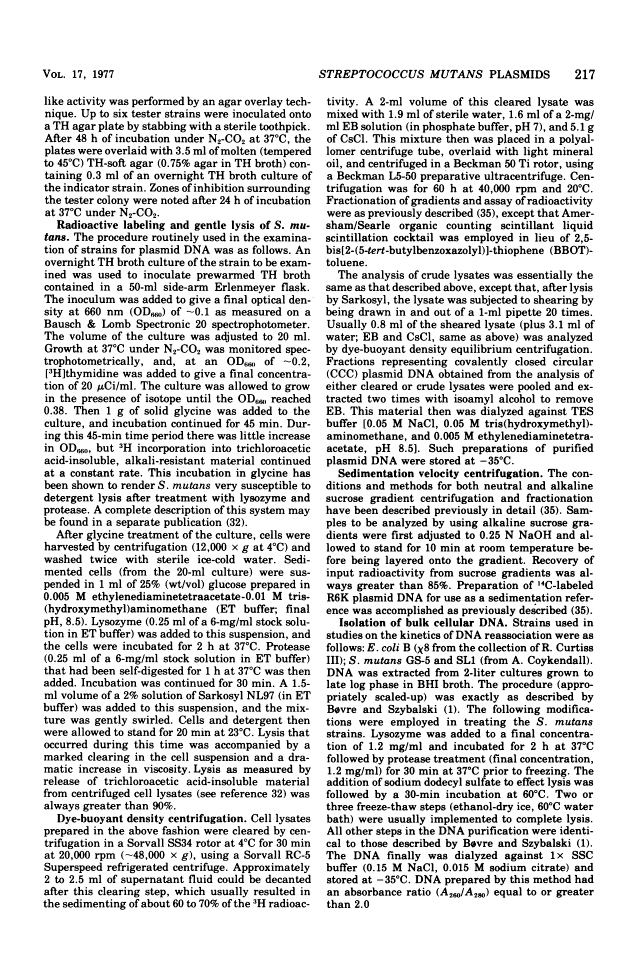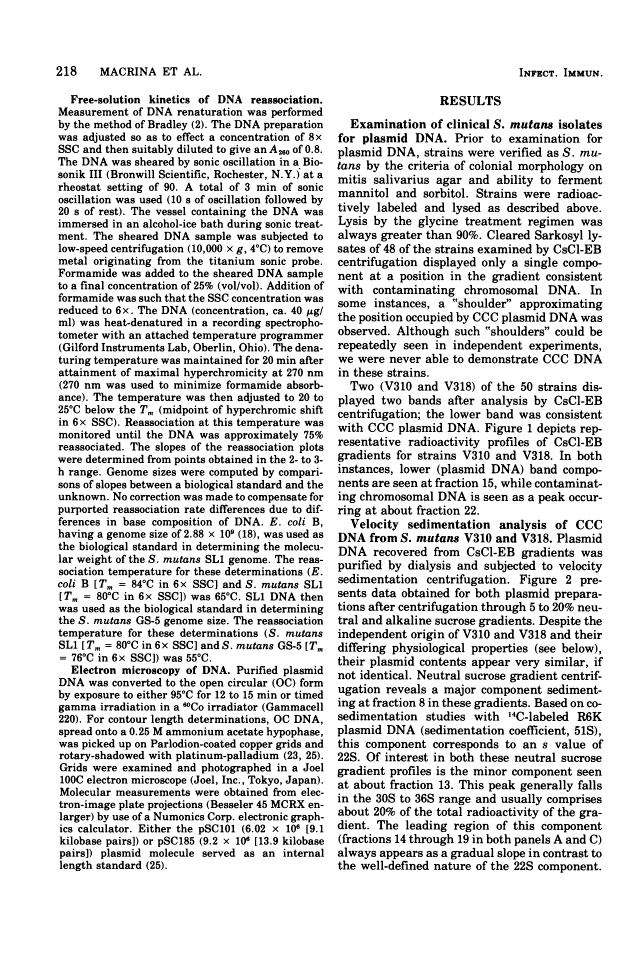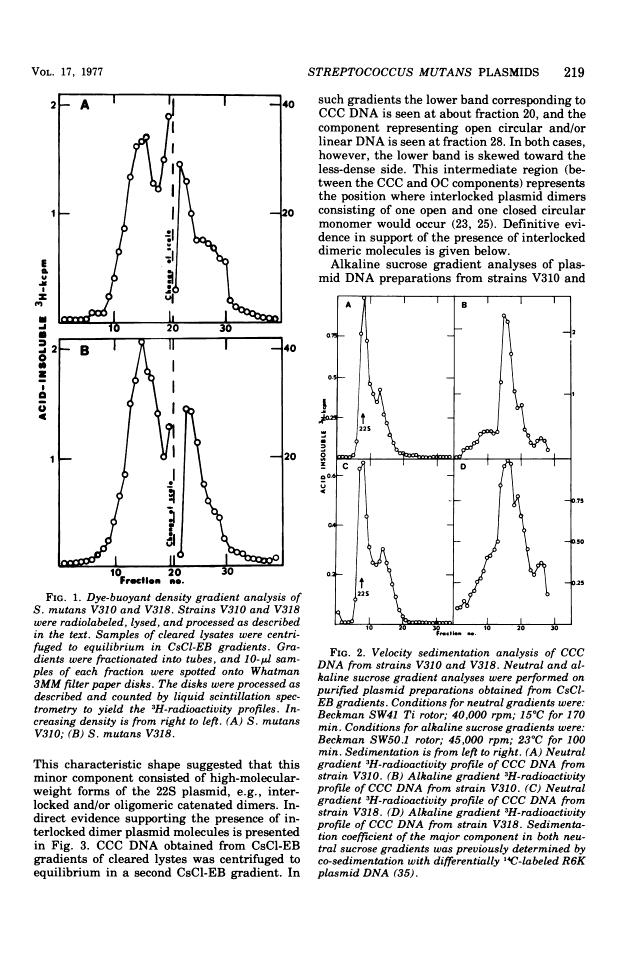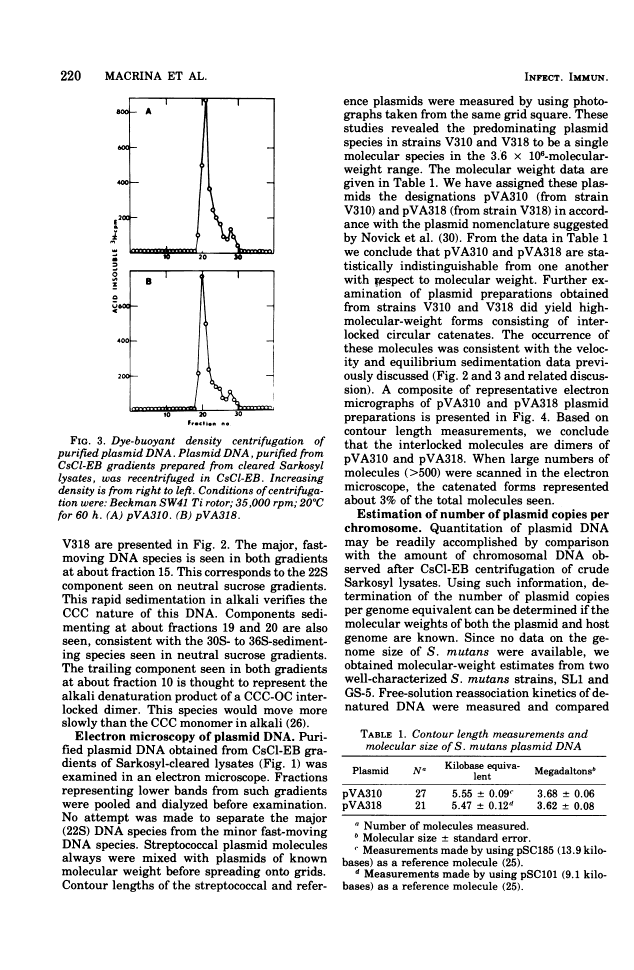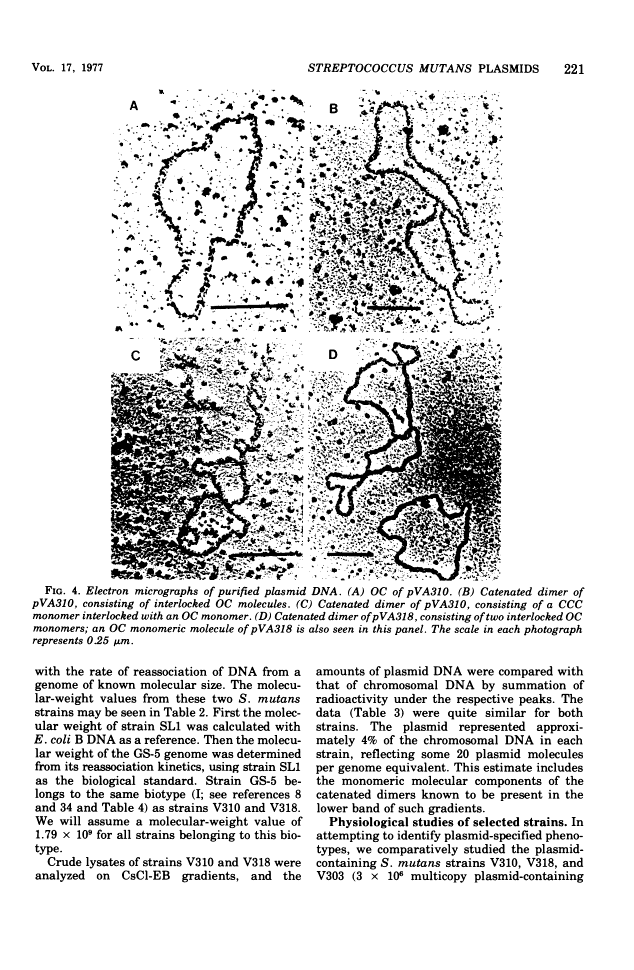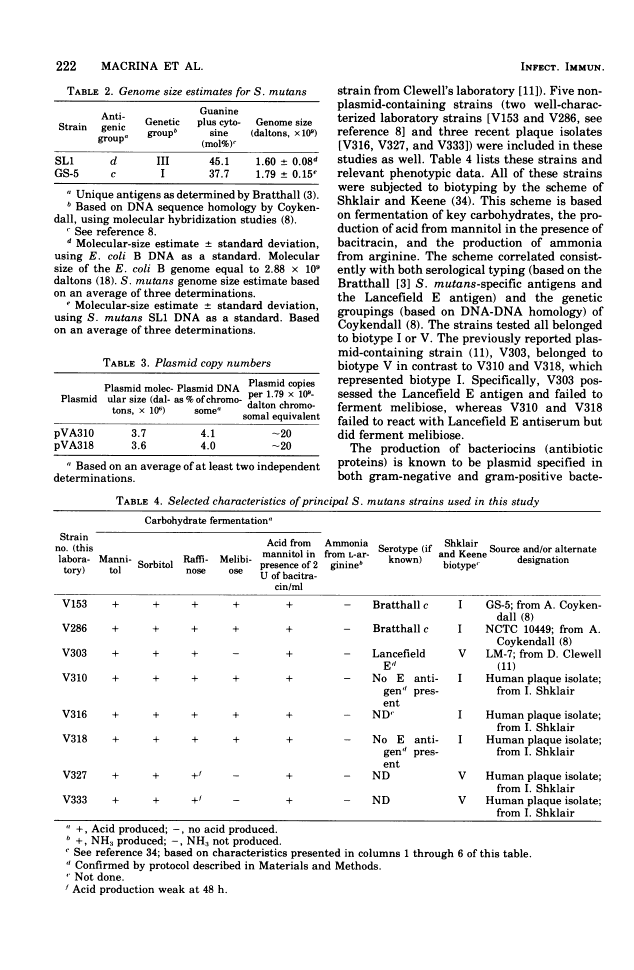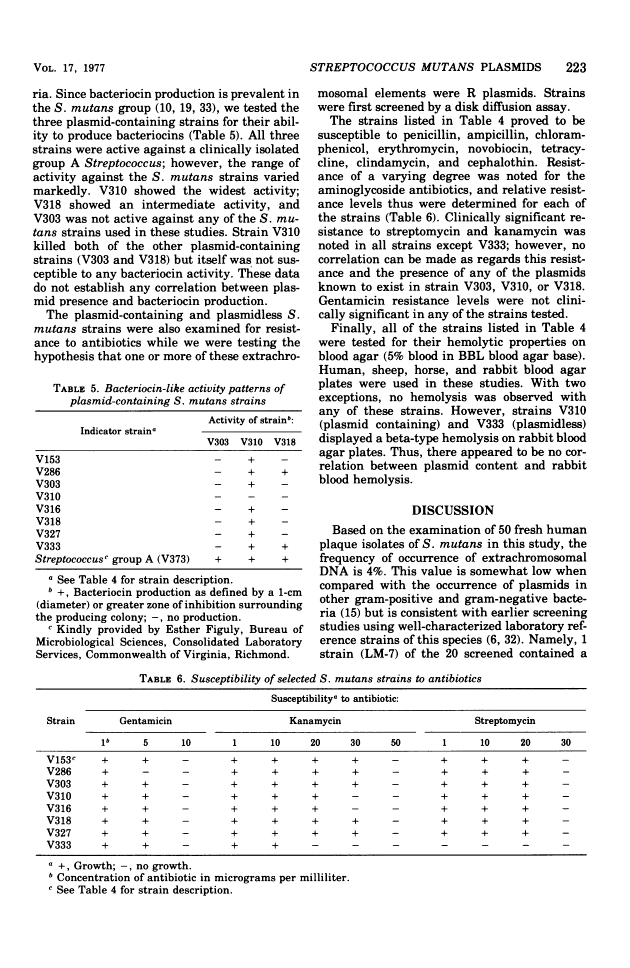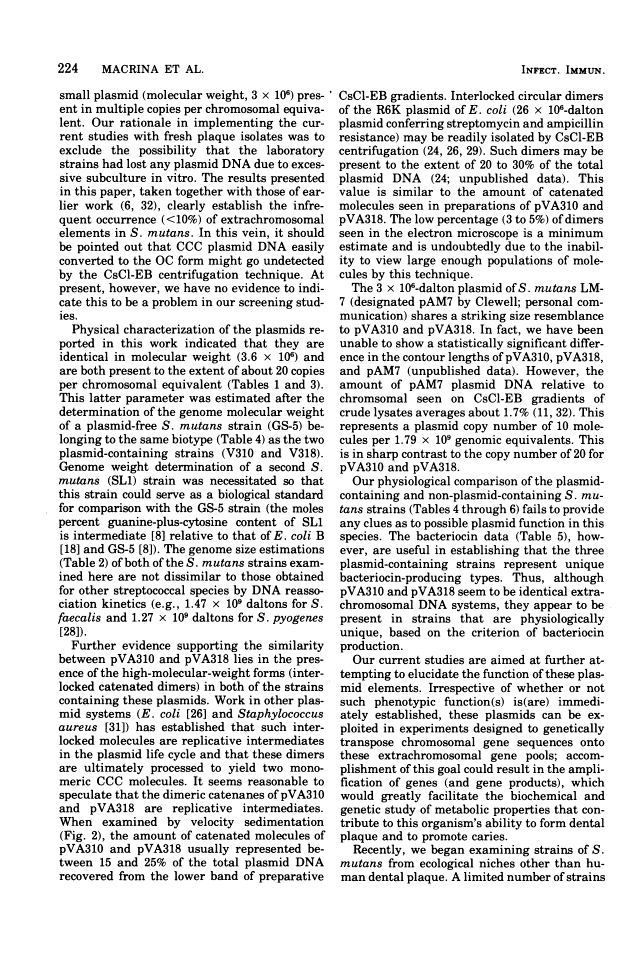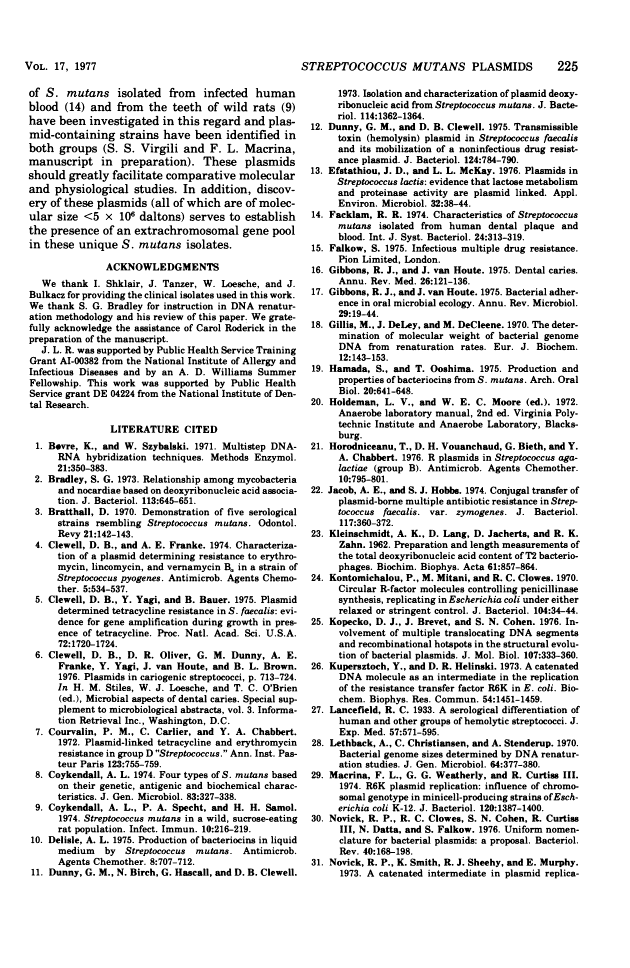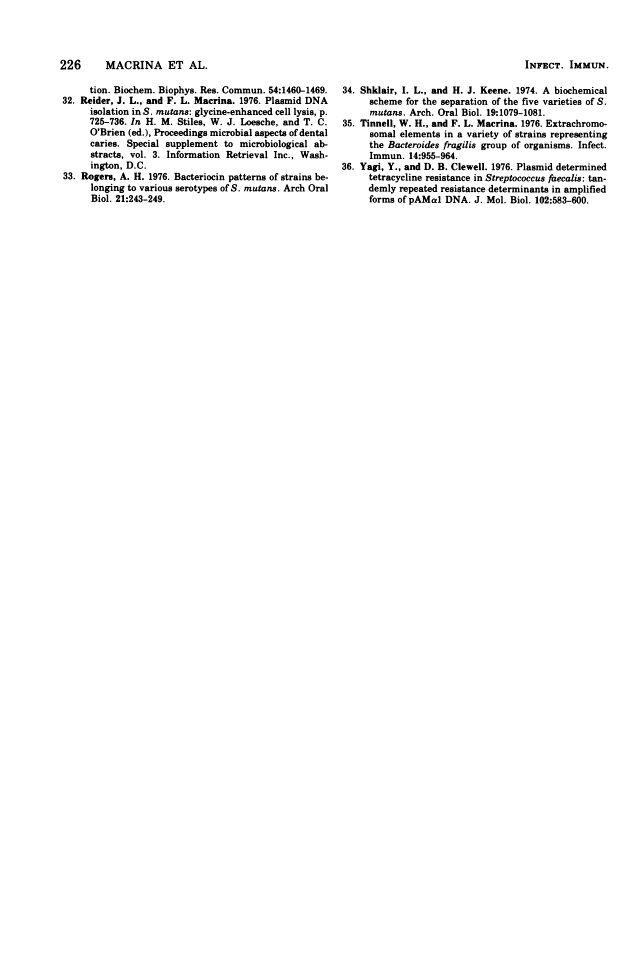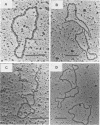Abstract
Free full text

Survey of the extrachromosomal gene pool of Streptococcus mutans.
Abstract
Fifty strains of Streptococcus mutans independently isolated from human dental plaque were examined for the presence of covalently closed circular plasmid deoxyribonucleic acid (DNA). Cesium chloride-ethidium bromide centrifugation of [3H]thymidine-labeled, Sarkosyl-lysed cells revealed that 2 of the 50 strains contained plasmid DNA. The plasmid DNA from these strains was characterized by velocity and equilibrium centrifugation and by electron microscopy. The plasmids in these strains were virtually identical in size, with molecular weights of 3.6 X 10(6) and 3.7 X 10(6), Both were present to the extent of approximately 20 molecules per genome equivalent. Interlocked catenated dimeric molecules of each plasmid were readily detected by velocity sedimentation and electron microscopy. These plasmid-containing strains were compared with representative plasmid-free S. mutans strains by using such criteria as bacteriocin production, antibiotic susceptibility, and hemolysis of mammalian erythrocytes. Although no correlation of phenotype to plasmid content could be made, production of bacteriocin-like activity differed significantly between the two plasmid-containing S. mutans isolates. Thus, although the plasmids in these two isolates appeared identical by the criteria of molecular weight, presence of dimers, and copy number, they appeared to be harbored by two distinct S. mutans strains.
Full text
Full text is available as a scanned copy of the original print version. Get a printable copy (PDF file) of the complete article (2.0M), or click on a page image below to browse page by page. Links to PubMed are also available for Selected References.
Images in this article
Click on the image to see a larger version.
Selected References
These references are in PubMed. This may not be the complete list of references from this article.
- Bradley SG. Relationships among mycobacteria and nocardiae based upon deoxyribonucleic acid reassociation. J Bacteriol. 1973 Feb;113(2):645–651. [Europe PMC free article] [Abstract] [Google Scholar]
- Bratthall D. Demonstration of five serological groups of streptococcal strains resembling Streptococcus mutans. Odontol Revy. 1970;21(2):143–152. [Abstract] [Google Scholar]
- Clewell DB, Franke AE. Characterization of a plasmid determining resistance to erythromycin, lincomycin, and vernamycin Balpha in a strain Streptococcus pyogenes. Antimicrob Agents Chemother. 1974 May;5(5):534–537. [Europe PMC free article] [Abstract] [Google Scholar]
- Clewell DB, Yagi Y, Bauer B. Plasmid-determined tetracycline resistance in Streptococcus faecalis: evidence for gene amplification during growth in presence of tetracycline. Proc Natl Acad Sci U S A. 1975 May;72(5):1720–1724. [Europe PMC free article] [Abstract] [Google Scholar]
- Courvalin PM, Carlier C, Chabbert YA. Plasmid-linked tetracycline and erythromycin resistance in group D "streptococcus". Ann Inst Pasteur (Paris) 1972 Dec;123(6):755–759. [Abstract] [Google Scholar]
- Coykendall AL. Four types of Streptococcus mutans based on their genetic, antigenic and biochemical characteristics. J Gen Microbiol. 1974 Aug;83(2):327–338. [Abstract] [Google Scholar]
- Coykendall AL, Specht PA, Samol HH. Streptococcus mutans in a wild, sucrose-eating rat population. Infect Immun. 1974 Jul;10(1):216–219. [Europe PMC free article] [Abstract] [Google Scholar]
- Delisle AL. Production of bacteriocins in a liquid medium by Streptococcus mutans. Antimicrob Agents Chemother. 1975 Dec;8(6):707–712. [Europe PMC free article] [Abstract] [Google Scholar]
- Dunny GM, Birch N, Hascall G, Clewell DB. Isolation and characterization of plasmid deoxyribonucleic acid from Streptococcus mutans. J Bacteriol. 1973 Jun;114(3):1362–1364. [Europe PMC free article] [Abstract] [Google Scholar]
- Dunny GM, Clewell DB. Transmissible toxin (hemolysin) plasmid in Streptococcus faecalis and its mobilization of a noninfectious drug resistance plasmid. J Bacteriol. 1975 Nov;124(2):784–790. [Europe PMC free article] [Abstract] [Google Scholar]
- Efstathiou JD, McKay LL. Plasmids in Streptococcus lactis: evidence that lactose metabolism and proteinase activity are plasmid linked. Appl Environ Microbiol. 1976 Jul;32(1):38–44. [Europe PMC free article] [Abstract] [Google Scholar]
- Gibbons RJ, van Houte J. Dental caries. Annu Rev Med. 1975;26:121–136. [Abstract] [Google Scholar]
- Gibbons RJ, Houte JV. Bacterial adherence in oral microbial ecology. Annu Rev Microbiol. 1975;29:19–44. [Abstract] [Google Scholar]
- Gillis M, De Ley J, De Cleene M. The determination of molecular weight of bacterial genome DNA from renaturation rates. Eur J Biochem. 1970 Jan;12(1):143–153. [Abstract] [Google Scholar]
- Hamada S, Ooshima T. Production and properties of bacteriocins (mutacins) from Streptococcus mutans. Arch Oral Biol. 1975 Oct;20(10):641–648. [Abstract] [Google Scholar]
- Horodniceanu T, Bouanchaud DH, Bieth G, Chabbert YA. R plasmids in Streptococcus agalactiae (group B). Antimicrob Agents Chemother. 1976 Nov;10(5):795–801. [Europe PMC free article] [Abstract] [Google Scholar]
- Jacob AE, Hobbs SJ. Conjugal transfer of plasmid-borne multiple antibiotic resistance in Streptococcus faecalis var. zymogenes. J Bacteriol. 1974 Feb;117(2):360–372. [Europe PMC free article] [Abstract] [Google Scholar]
- KLEINSCHMIDT AK, LANG D, JACHERTS D, ZAHN RK. [Preparation and length measurements of the total desoxyribonucleic acid content of T2 bacteriophages]. Biochim Biophys Acta. 1962 Dec 31;61:857–864. [Abstract] [Google Scholar]
- Kontomichalou P, Mitani M, Clowes RC. Circular R-factor molecules controlling penicillinase synthesis, replicating in Escherichia coli under either relaxed or stringent control. J Bacteriol. 1970 Oct;104(1):34–44. [Europe PMC free article] [Abstract] [Google Scholar]
- Kopecko DJ, Brevet J, Cohen SN. Involvement of multiple translocating DNA segments and recombinational hotspots in the structural evolution of bacterial plasmids. J Mol Biol. 1976 Dec;108(2):333–360. [Abstract] [Google Scholar]
- Kupersztoch YM, Helinski DR. A catenated DNA molecule as an intermediate in the replication of the resistance transfer factor R6K in Escherichia coli. Biochem Biophys Res Commun. 1973 Oct 15;54(4):1451–1459. [Abstract] [Google Scholar]
- Bak AL, Christiansen C, Stenderup A. Bacterial genome sizes determined by DNA renaturation studies. J Gen Microbiol. 1970 Dec;64(3):377–380. [Abstract] [Google Scholar]
- Macrina FL, Weatherly GG, Curtiss R., 3rd R6K plasmid replication: influence of chromosomal genotype in minicell-producing strains of Escherichia coli K-12. J Bacteriol. 1974 Dec;120(3):1387–1400. [Europe PMC free article] [Abstract] [Google Scholar]
- Novick RP, Clowes RC, Cohen SN, Curtiss R, 3rd, Datta N, Falkow S. Uniform nomenclature for bacterial plasmids: a proposal. Bacteriol Rev. 1976 Mar;40(1):168–189. [Europe PMC free article] [Abstract] [Google Scholar]
- Rogers AH. Bacteriocin patterns of strains belonging to various serotypes of Streptococcus mutans. Arch Oral Biol. 1976;21(4):243–249. [Abstract] [Google Scholar]
- Shklair IL, Keene HJ. A biochemical scheme for the separation of the five varieties of Streptococcus mutans. Arch Oral Biol. 1974 Nov;19(11):1079–1081. [Abstract] [Google Scholar]
- Tinnell WH, Macrina FL. Extrachromosomal elements in a variety of strains representing the Bacteroides fragilis group of organisms. Infect Immun. 1976 Oct;14(4):955–964. [Europe PMC free article] [Abstract] [Google Scholar]
- Yagi Y, Clewell DB. Plasmid-determined tetracycline resistance in Streptococcus faecalis: tandemly repeated resistance determinants in amplified forms of pAMalpha1 DNA. J Mol Biol. 1976 Apr 15;102(3):583–600. [Abstract] [Google Scholar]
Associated Data
Articles from Infection and Immunity are provided here courtesy of American Society for Microbiology (ASM)
Full text links
Read article at publisher's site: https://doi.org/10.1128/iai.17.1.215-226.1977
Read article for free, from open access legal sources, via Unpaywall:
https://iai.asm.org/content/iai/17/1/215.full.pdf
Free after 4 months at iai.asm.org
http://iai.asm.org/cgi/reprint/17/1/215
Free to read at iai.asm.org
http://iai.asm.org/cgi/content/abstract/17/1/215
Citations & impact
Impact metrics
Citations of article over time
Alternative metrics
Smart citations by scite.ai
Explore citation contexts and check if this article has been
supported or disputed.
https://scite.ai/reports/10.1128/iai.17.1.215-226.1977
Article citations
Cryptic Streptococcus mutans 5.6-kb plasmids encode a toxin-antitoxin system for plasmid stabilization.
J Oral Microbiol, 5, 15 Jan 2013
Cited by: 1 article | PMID: 23330057 | PMCID: PMC3547324
Isolation of bacterial extrachromosomal DNA from human dental plaque associated with periodontal disease, using transposon-aided capture (TRACA).
FEMS Microbiol Ecol, 78(2):349-354, 29 Jul 2011
Cited by: 11 articles | PMID: 21711368 | PMCID: PMC3263338
Genetic classification of severe early childhood caries by use of subtracted DNA fragments from Streptococcus mutans.
J Clin Microbiol, 46(9):2868-2873, 02 Jul 2008
Cited by: 10 articles | PMID: 18596144 | PMCID: PMC2546765
Population structure of plasmid-containing strains of Streptococcus mutans, a member of the human indigenous biota.
J Bacteriol, 189(4):1238-1243, 03 Nov 2006
Cited by: 16 articles | PMID: 17085559 | PMCID: PMC1797337
Complete nucleotide sequence and characterization of pUA140, a cryptic plasmid from Streptococcus mutans.
Plasmid, 46(2):77-85, 01 Sep 2001
Cited by: 20 articles | PMID: 11591133
Go to all (57) article citations
Similar Articles
To arrive at the top five similar articles we use a word-weighted algorithm to compare words from the Title and Abstract of each citation.
Isolation and characterization of four plasmids from Bacillus subtilis.
J Bacteriol, 129(3):1487-1494, 01 Mar 1977
Cited by: 50 articles | PMID: 403179 | PMCID: PMC235126
Isolation of plasmid deoxyribonucleic acid from two strains of Bacteroides.
J Bacteriol, 124(1):503-510, 01 Oct 1975
Cited by: 8 articles | PMID: 1100611 | PMCID: PMC235920
Evidence for a disseminated plasmid in Streptococcus mutans.
Infect Immun, 20(1):296-302, 01 Apr 1978
Cited by: 27 articles | PMID: 669797 | PMCID: PMC421849
Extrachromosomal elements in a variety of strains representing the Bacteroides fragilis group of organisms.
Infect Immun, 14(4):955-964, 01 Oct 1976
Cited by: 13 articles | PMID: 992876 | PMCID: PMC415478
